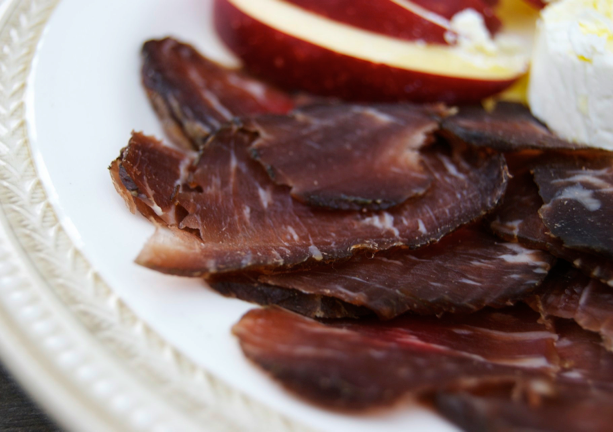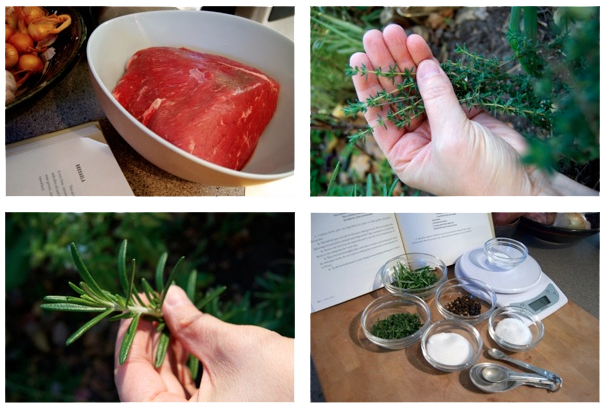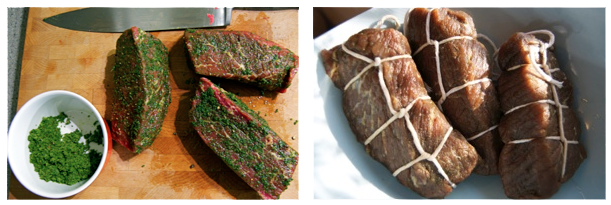
Bresaola is remarkable food. Like a woodsy prosciutto with a full beef flavor, bresaola is silky, herbaceous and complex. This cured meat knocked me off my feet. I made this myself? So cool.
This month’s challenge for Charcutepalooza was dry cured meats, the pinnacle of advanced charcuterie technique. I chose to cure a whole cut of meat instead of a compound product like salami, as I haven’t had the greatest luck with stuffing casings. In some ways bresaola was very similar to one of our first challenges, which was duck prosciutto. But the cut of meat is larger and the dry curing time is much longer. I’d seen several horror story postings on curing bresaola where mold over took the process, the meat rotten on the inside, it was attacked by vermin or dried into tough shoe leather. Hmm, maybe salumi was a better idea…
Armed with Michael Ruhlman’s recipe for bresaola from Charcuterie, and a fantastic blog post from Wrightfood, I set out to make this exotic cured beef. The first thing you’ll notice about the recipe is that it calls for lean eye of round, which is not a cut of meat I’d ever buy to cook with. It’s tough, rather bland and cooks poorly due to is low fat content. The second interesting thing you’ll notice is that the predominate spice is juniper berries. It’s a very powerful flavor so I was skeptical that the beef wouldn’t be overwhelmed this its bitter resinous flavor. Add on top of the juniper a big dose of fresh rosemary, thyme and cracked pepper, and you’ve got yourself one potent cocktail.
To prepare the meat I removed all of the exterior fat and silver skin, then divided it into three equal pieces, cutting with the grain. In addition to the herbs and spices, I added sodium nitrate, salt and sugar. Because the beef cures at 54 degrees, well above refrigerator temp, it’s a good idea to use a nitrate. It slowly breaks down into nitrite, preserving the meat over time as it cures, keeping out those bad scary bugs like botulism and other nasty bacteria. The meat, while preserved, is still essentially raw, having never been above room temperature. You definitely want to keep those bad boys out. You can also do it with salt alone, but you need quite a lot of it.
I combined all the herbs, spices, salts and sugar in my coffee grinder and ground them to a paste. Half of the paste was rubbed on the meat, then it went into a big ziplock bag in the fridge. Each day I turned the bag, redistributing the liquid. After a week I took the beef out, rinsed it off, rubbed it with the second half of the spice mixture, then placed in a new ziplock bag. Back in the fridge it went to cure for one more week.
After two weeks of curing in the fridge, the beef was ready to dry cure. I rinsed the beef throughly, then tied it up in butchers twine. My wine fridge, which sits comfortably at 54 degrees, was my intended curing box. I placed a pan with two inches of heavily salted water in the bottom to humidify the environment. This is very important as it slows down the drying process, giving the interior of the beef time to dry before the exterior becomes impermeable to water. If the exterior dries out to fast the center of the beef might rot. Eew! But you don’t want it to be to damp, or you’ll be battling some pretty nasty mold.
The goal of drying in this environment is to dehydrate the meat just enough to preserve it further, intensify the flavors, and promote beneficial bacterial action, which adds some acid and other fantastic flavors to the product, just like aging prime beef. My beef started out 950 grams before entering the wine fridge. The recommended weight loss is 30%, which is a good indicator or when it’s ready. It took it out at 635 grams.
I served my first slices of beef on top of a field greens salad dressed with olive oil, balsamic and shaved parmesan cheese. Amazing! The first flavor that hits your palette is juniper, followed by a subtle piney flavor of the rosemary, finishing with thyme and pepper. For something that cured for almost 5 weeks, the herbs tasted very fresh. The texture was buttery with a little chewiness to it, but not at all tough. It rounds out with a pronounced meatiness. Bresaola was like nothing I’ve ever tasted. I can’t wait to share!

